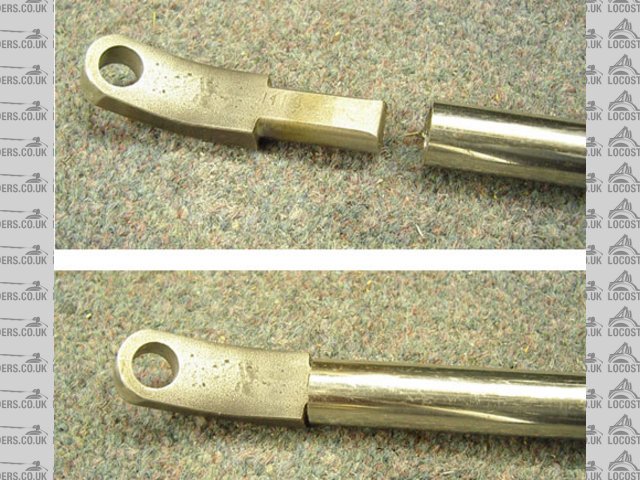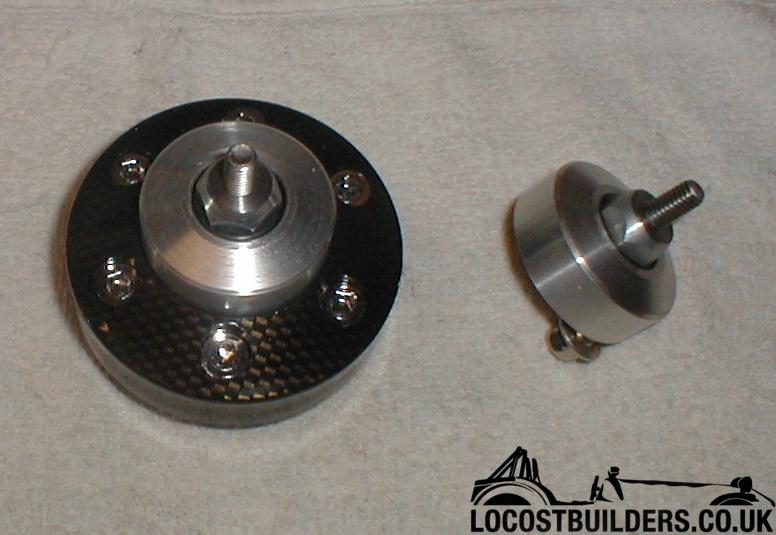
Cycle wing brackets - new design project?
David Jenkins - 12/7/07 at 04:08 PM
Here's a suggestion: how about some of the keen engineering design chappies having a go at the front cycle wing brackets?
All the designs I've seen to date are at risk of fracture due to flexing, which is not surprising when you consider that the whole assembly is a
large lump of GRP flapping around on the end of long steel bars and/or tubes. Some people have been lucky with what they've got, while others
have had them fail (like me).
Looking at mine today, it's clear that the structure needs depth to stiffen the structure, but there's not a lot of space on a Cortina
upright to allow thicker brackets.
The alternative would be to support the mudguard on the outer side, but that could be - er - tricky!  . I suppose that you could have a bearing on
the end of the axle...
. I suppose that you could have a bearing on
the end of the axle...
So, any sensible suggestions? Other than 'mine work ok, I've never had them break', 'cos that's where I was until a few days
ago.
So, any ideas?
cheers,
David
worX - 12/7/07 at 04:12 PM
I've just blatantly stole this from Dave's archive...
Steve
[img][/img]
smart51 - 12/7/07 at 04:16 PM
Both of mine have failed at different times. Both times, the tube snapped in the heat affected zone where the mounting bracket is welded that bolts
to the top of the sierra upright. The forces acting on the arm must pivot at that point.
David Jenkins - 12/7/07 at 04:18 PM
That looks - odd - but it is interesting. I wonder if those thin outer uprights are strong enough? They must help a bit.
Which 'Dave' is that? And does he have more pictures?
David Jenkins - 12/7/07 at 04:20 PM
quote:
Originally posted by smart51
Both of mine have failed at different times. Both times, the tube snapped in the heat affected zone where the mounting bracket is welded that bolts
to the top of the sierra upright. The forces acting on the arm must pivot at that point.
Mine went in a similar place, just above the mounting bolt. Basically, it's the place where the flexing stops, in my case.
StevieB - 12/7/07 at 04:23 PM
How about just putting some supporting webs on the various bends and joint, to give a bit more rigidity in the right places?
David Jenkins - 12/7/07 at 04:26 PM
Trouble is, I think you'll just move the fracture point somewhere else, unless you can shape the metal to share the load across most of its
length.
nathanharris1987 - 12/7/07 at 04:37 PM
think big in small spaces... the most common design of material to resist bending is I sections and box sections.
And beings you have such a small conection to the upright and such a large span away from it to what is effectively a air catching cup, the bending
moment would be at a maximum furthest away from the grp ie, close to the mounting.
As david said you'd need to share the load so what i'd do is put a perpendicular flange or extra metal from the joint, gradually lessening
towards the top if ya get what i mean.
Wadders - 12/7/07 at 04:40 PM
I had a few fracture, then i decided to braze them instead of welding, no problems since.
Al.
David Jenkins - 12/7/07 at 04:45 PM
Except mine didn't break at a weld! Each stay is a continuous length of 25mm wide, 5.5mm thick steel bar, bent to suit. Two holes on the front
bar, and one at the back, with spacers to hold them off the upright and clear the bumps. the only welds are on a cross-brace - and one of those only
broke 'cos it was a rubbish weld. I chose to make it this way to eliminate as many welds as I could.
One stay broke next to the top front bolt, where it's rigidly held. It was a text-book fatigue fracture.
Mark Allanson - 12/7/07 at 04:50 PM
My design does away with the stays altogether, over 2 years and 8k miles without any problems
907 - 12/7/07 at 04:57 PM
I can't say if mine are any better or worse as they haven't been tried & tested yet,
but I did come up with the joint shown below.
Theory says, that by turning a round on the end of the lug, then sliding this inside the tube,
you move the stress point away from the weld area, er, maybe???
Paul G


Rescued attachment pipe-to-bar-m-s.jpg
David Jenkins - 12/7/07 at 06:10 PM
quote:
Originally posted by 907
Theory says, that by turning a round on the end of the lug, then sliding this inside the tube, you move the stress point away from the weld area, er,
maybe???
Paul, you may be right - but I wouldn't like to put any serious money on it! 
Avoneer - 12/7/07 at 06:14 PM
Mine were fine on the avon - just two lengths of 30x3mm flat bent to go under the arches.
My new ones are made from 3mm plate and in one piece - but the caterham csr arches have cocky front mountings anyway.
Pat...
robertst - 12/7/07 at 06:19 PM
why not just use thicker walled tube and plate?
David Jenkins - 12/7/07 at 06:21 PM
quote:
Originally posted by Mark Allanson
My design does away with the stays altogether, over 2 years and 8k miles without any problems
Go on then - give us a clue! 
...or some pictures, anyway. 
chriscook - 12/7/07 at 07:17 PM
The aerodynamic load on the cycle wings is quite high - I can't remember what kind of figure it is but Rob Palin might be along to tells us. Add
that to them bouncing up and down with the wheel. Then add that its quite common for them to be welded and the fatigue of welded joints basically
assumes cracks have already initiated from the welding process.
No wonder its a common failure.
As Wadders says brazing or bronze welding would be better than normal welding.
Wadders - 12/7/07 at 07:50 PM

 ever so slightly deformed, i'll agree
ever so slightly deformed, i'll agree 
Originally posted by chris mason
are you sure Al, that nearside front bracket looked broken to me on saturday 




Chris
David Jenkins - 12/7/07 at 08:00 PM
quote:
Originally posted by chriscook
As Wadders says brazing or bronze welding would be better than normal welding.
See previous posting - no welds were involved in my breakage (apart from the incidental one on a cross-brace). It was a classic fatigue fracture in
'virgin metal'.
Though you're right about the severe loads on these bits - hence my wish for a better bracket design.
[Edited on 12/7/07 by David Jenkins]
Mark Allanson - 12/7/07 at 11:07 PM
quote:
Originally posted by David Jenkins
quote:
Originally posted by Mark Allanson
My design does away with the stays altogether, over 2 years and 8k miles without any problems
Go on then - give us a clue! 
...or some pictures, anyway. 
OK seeing as you asked so nicely, the red bit is a post photo modification, puts all the load on the 13mm ERW section bent to the same radius (bent
over the tyre)


Rescued attachment ModCycleWings2.jpg
David Jenkins - 13/7/07 at 08:04 AM
I was mulling this over last night...
How about a 'leaf spring' arrangement from the mounting bolts to the wing? I'm thinking of 3 or 4 quite thin leaf springs getting
progressively shorter, all bound together like an old-fashioned cart spring. It wouldn't have to flex much, but it would spread the bending load
along the whole length of the stay. I'm not sure where I'd get suitable material though...
Mark - your solution looks very solid - I guess it overcomes the problem by sheer brute force!  Only joking - it does look like a tidy result.
Only joking - it does look like a tidy result.
DJ
[Edited on 13/7/07 by David Jenkins]
locoR1 - 13/7/07 at 11:54 AM
Hi David,
A couple of pictures of my wheel centers you will probably get the idea from the pics,
Basically an aluminum wheel center with two small bearings in with a bolt through the middle.
I've had them on the car for about 4 years now with no problems! I think I've probably only repacked the bearing once!
.jpg)

Cheers Dave..............
David Jenkins - 13/7/07 at 02:23 PM
Very neat, Dave! I might investigate that option...
C10CoryM - 14/7/07 at 02:33 AM
Well, first thing an engineer would probably tell you to do is toss the fibreglass and go with carbon fibre wings  . Reduce the forces on the
brackets is step one IMO.
. Reduce the forces on the
brackets is step one IMO.
I would guess there are 2 ways to deal with this, either use tapered spring steel and let it flex, or make it stiff enough to not flex enough to
fracture.
What is the average weight of a fibreglass wing? I will see if I can convince an engineering student to do a cycle wing in FEA for his class.
Ive wondered if a cable would work. Pictured in red and pulled taut it would be loaded in tension and take the shock load of the downward movement of
the wing. Cables generally dont like shock loads, but Im sure it could handle that much. Or at least give you warning when it snapped.
Cheers.


Rescued attachment stays.JPG
 . I suppose that you could have a bearing on
the end of the axle...
. I suppose that you could have a bearing on
the end of the axle... 






.jpg)